- Home
- Prelims
- Mains
- Current Affairs
- Study Materials
- Test Series
 EDITORIALS & ARTICLES
EDITORIALS & ARTICLES
Feb 01, 2022
HOME DELIVERY OF MEDICINES WILL BEGIN FROM 1ST FEBRUARY 2022 UNDER SERVICES E-HEALTH ASSISTANCE AND TELECONSULTATION (SEHAT).
Recently, the government has decided to start Home Delivery of medicines under SERVICES e-HEALTH ASSISTANCE AND TELECONSULTATION (SeHAT).
 What is SeHAT?
What is SeHAT?
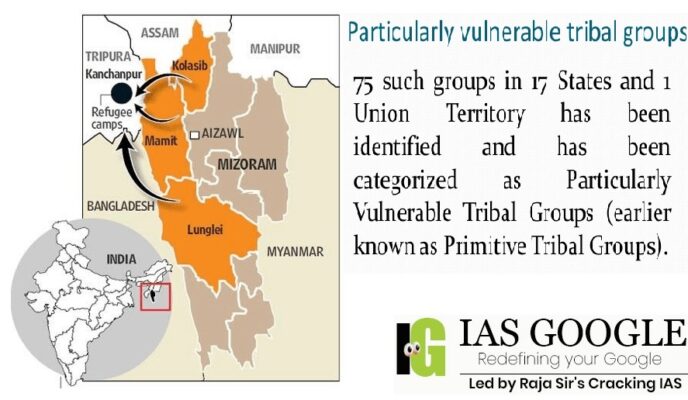 Who is Bru’s?
Who is Bru’s?
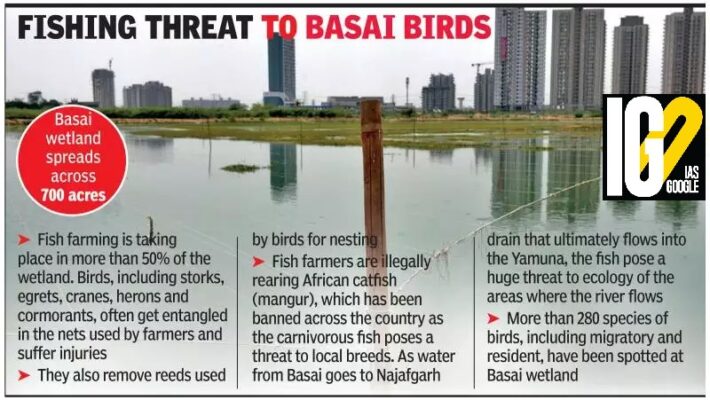 Basai Wetland:
Basai Wetland:
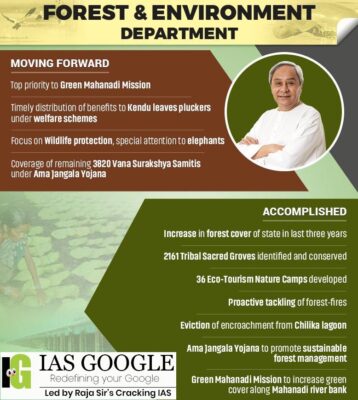
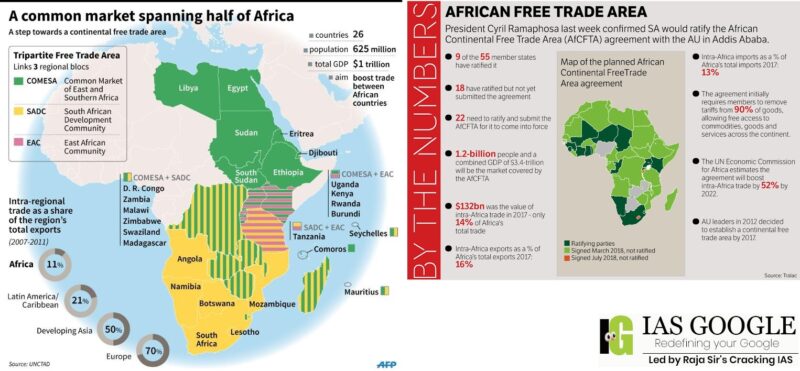 Unlike in other regions of the world, the value of intra-Africa trade has remained low over the years. Moreover, Africa accounts for just 2 percent of global trade. In 2021, African countries launched the African Continental Free Trade Area (AfCFTA), which aims to create a single African market for the free movement of goods, services, labour, and capital, and increase intra-African trade.
Free Trade Agreement?
Unlike in other regions of the world, the value of intra-Africa trade has remained low over the years. Moreover, Africa accounts for just 2 percent of global trade. In 2021, African countries launched the African Continental Free Trade Area (AfCFTA), which aims to create a single African market for the free movement of goods, services, labour, and capital, and increase intra-African trade.
Free Trade Agreement?
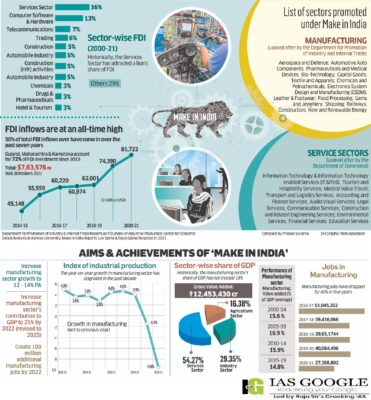 Unfazed by the disruptions caused by Covid-19 pandemic, Micro, Small and Medium Enterprises (MSMEs) in the country have lined up to support the indigenisation programme of the Indian defence forces.
Indigenisation of Defence sector in needed?
Unfazed by the disruptions caused by Covid-19 pandemic, Micro, Small and Medium Enterprises (MSMEs) in the country have lined up to support the indigenisation programme of the Indian defence forces.
Indigenisation of Defence sector in needed?
 What is SeHAT?
What is SeHAT?
- It is the tri-services teleconsultation service of the MoD designed for all entitled personnel and their families.
- SeHAT stay home OPD is a patient-to-doctor system where the patient can consult a doctor remotely through the internet using his Smartphone, laptop, Desktop or Tablet.
- It also includes all ECHS beneficiaries.
- SeHAT Stay Home OPD has been developed by HQ IDS and DGAFMS in collaboration with the Centre for Development for Advanced Computing (CDAC Mohali).
- It is based on the lines of eSanjeevani a similar free OPD service run by the MoHFW for all citizens.
- Scalable SeHAT OPD is hosted on NIC Cloud with Private Subnets, Firewalls, WAF (Web Application Firewall), Anti-DDoS solution, Geo-fencing (restrict users outside India), Encryption - Data at rest and while transit.
- It aims to provide quality healthcare services to patients from the comfort of their homes.
- Safe and structured video-based clinical consultations between a doctor in a hospital, and a patient within the confines of his or her home anywhere in the country, have been enabled.
- It is designed to be extremely simple and easy to use, which requires minimal effort from the users.
- The E Sanjeevani OPD has been launched to help all of the people who are finding it very difficult to get health advice from the doctors because of the coronavirus pandemic.
- It is Government of India's flagship telemedicine technology developed by the Centre for Development of Advanced Computing (Mohali).
- The main objective of eSanjeevani OPD is to provide health advice to individuals with the help of digitalization.
- 515 displaced Brus were moved out of their camps in the North Tripura district and sent to two locations in Dhalai district in the state as a part of the permanent resettlement of the refugees.
- A quadripartite agreement was signed between the Bru leaders and Central, Tripura, and Mizoram governments in January last year for the resettlement of some 35,000 Brus from Mizoram.
 Who is Bru’s?
Who is Bru’s?
- They are a community indigenous to the Northeast, living mostly in Tripura, Mizoram, and Assam.
- In Tripura, they are recognised as a Particularly Vulnerable Tribal Group.
- In Mizoram, they were targeted by ethnic organisations who demanded that the Brus be excluded from electoral rolls.
- Their exodus in 1997 was spurred by violent clashes in Mamith subdivision, a Reang-dominated area when they demanded the creation of an autonomous council that was vehemently opposed by Mizo groups.
- In January 16, 2020, a final quadripartite pact was signed by the governments of Tripura and Mizoram, along with the Centre and Bru organisations to settle around 32,000 Brus in Tripura permanently.
- Bru, who returned to Mizoram in the eight phases of repatriation since 2009, cannot, however, come back to Tripura.
- To ascertain the numbers of those who will be settled, a fresh survey and physical verification of Bru families living in relief camps will be carried out.
- All cash assistance will be through Direct Benefit Transfer (DBT), and the state government will expedite the opening of bank accounts and the issuance of Aadhaar, permanent residence certificates, ST certificates, and voter identity cards to the beneficiaries.
 Basai Wetland:
Basai Wetland:
- Basai wetland, located in Basai village in Gurgaon tehsil in Gurgaon district in Haryana, India, is a flora and fauna rich water body.
- Basai wetland lies in one of the paleochannel of the Sahibi River, a tributary of Yamuna which originates from the Aravalli range in Rajasthan and flows through west and South Haryana into Delhi where it is also known as the Najafgarh drain.
- Basai is recognised as a key biodiversity area by the International Union for Conservation of Nature (IUCN), the Wildlife Institute of India and the Bird Life International, a global network of NGOs that work to protect bird habitats.
- The wetland continues to disappear under newly laid roads, modern housing constructions and other infrastructure development.
- An upcoming expressway, cutting through the terrain here, has majorly impacted the flyway of thousands of migratory birds from Europe and Central Asia.
- Lack of awareness about the history and importance of wetlands among the people.
- Ultimately, it would be to the peril of the residents when the threat of water scarcity, receding groundwater table, flash floods during heavy rains and the sight of depleting greenery from their high-rise windows turn into a bitter reality.

- Around 72 logs of Phasi, 14 feet in length and 6 feet in girth are used for making the wheels of the Jagannatha chariots.
- These logs mostly came from private land owners. They donated the logs to the temple committee for the chariot.
- Around 865 logs of Phasi, Dhaura (Anogeissus latifolia), Asan (Terminalia elliptica) and Simal (Bombax ceiba), along with a few others, are the tree species majorly used for the construction of chariots of Jagannath, Balabhadra and Subhadra every year.
- Anogeissus latifolia is a species of small to medium-sized tree native to the India, Nepal, Myanmar, and Sri Lanka.
- Phasi trees grow are mostly found in the alluvial floodplain of the Mahanadi.
- Phasi trees take 50-60 years to mature.
- Its leaves contain large amounts of gallotannins, and are used in India for tanning and firewood.
- The tree is the source of Indian gum, also known as ghatti gum, which is used for calico printing among other uses.
- An erect tree sometimes reaching 18-21 m bark, smooth, light coloured, young parts glabrous or silky pubescent.
- Bark useful in diarrhoea, dysentery, cough, headache.
- Gum used in leucorrhoea and tonic in postnatal treatment.
- The wood is extensively used for axle handles, construction, agricultural implements, house posts, poles, excellent fuel and charcoal, yields a gum used in Calica printing.
- Leaves used for tanning.
- Terminalia elliptica is a species of Terminalia native to southern and southeast Asia in India, Nepal, Bangladesh, Myanmar, Thailand, Laos, Cambodia, and Vietnam.
- Outside of its native range, it is cultivated in southern China.
- It is a prominent part of both dry and moist deciduous forests in southern India up to 1000 m.
- The bark is fire-resistant. The wood is coarse, fairly straight grained, dull to somewhat lustrous and without any smell or taste.
- Terminalia tomentosa has a remarkable attribute: some members of the species store water in the dry season.
- The leaves are used as food by Antheraea paphia (silkworms) which produce the tassar silk (Tussah), a form of commercially important wild silk.
- Water stored in the stem is often tapped and used as a source of potable water in the summer by forest folk.
- Loss of forest cover.
- Their regeneration has been affected.
- Rapid climate change leading to erratic rainfall and cyclones in the region.
- The survival rate of the plantations too has cast a shadow on the project since slow growth will mean longer gestation period.
- As part of the Green Mahanadi Mission, spreading awareness among the masses and requesting them to start growing Dhaura trees on their land along with fruit trees. These woods should be added in sacred grooves category for their conservation.
- The alarm bells signaling the urgent need to reclaim the ecological cover and rescue the environment have once again been sounded. And people should be worried, if only for god's sake.
- Ratha Jatra, the Festival of Chariots of Lord Jagannatha is celebrated every year at Puri, the temple town in Orissa, on the east coast of India.
- The presiding deities of the main temple, Sri Mandira, Lord Jagannatha, Lord Balabhadra and Goddess Subhadra, with the celestial wheel Sudarshana are taken out from the temple on their respective chariots.
- The huge, colourfully decorated chariots are drawn by hundreds and thousands of devotees on the badadanda, the grand avenue to the Gundicha temple, some two miles away to the North.
- After a stay for seven days, the deities return to their abode in Srimandira.
- Other names:The festival is also known as Gundicha Jatra, Ghosa Jatra, Navadina Jatra, Dasavatara Jatra and by a variety of other names.
 Unlike in other regions of the world, the value of intra-Africa trade has remained low over the years. Moreover, Africa accounts for just 2 percent of global trade. In 2021, African countries launched the African Continental Free Trade Area (AfCFTA), which aims to create a single African market for the free movement of goods, services, labour, and capital, and increase intra-African trade.
Free Trade Agreement?
Unlike in other regions of the world, the value of intra-Africa trade has remained low over the years. Moreover, Africa accounts for just 2 percent of global trade. In 2021, African countries launched the African Continental Free Trade Area (AfCFTA), which aims to create a single African market for the free movement of goods, services, labour, and capital, and increase intra-African trade.
Free Trade Agreement?
- A free trade agreement allows for duty-free trade within a specified area, and members set their own tariffs on imports from non-members.
- The Organisation for Economic Cooperation and Development (OECD) adopts a broader notion that includes non-tariff barriers as well, defining a free trade area as “a grouping of countries within which tariffs and non-tariff trade barriers between the members are generally abolished but with no common trade policy toward non-members.”
- The African continent first engaged in trade integration after independence, with the establishment of the Organization of African Unity (OAU) in 1963 comprising 32 countries for promoting understanding and cooperation among the member states.
- Along with political purpose, with the passage of time commercial and economic interests gained prominence, with the aim of nurturing self-reliance for the African continent.
- Today the African Union is the largest regional grouping in the world with 55 member states.
- Among its goals is to promote free trade within Africa, and in 2012, it decided to establish a free trade area. This resulted in the adoption and signing of the African Continental Free Trade Area (AfCFTA) in 2018.
- Regarded as a flagship project of the Africa’s Development Framework Agenda 2063, the AfCTA is a preferential arrangement that includes a Free Trade Agreement and a Protocol for Free Movement of Persons. It entered into force in May 2019 and trade under AfCFTA began on 1 January 2021.
- One of the objectives of the free trade area is to enhance intra-Africa trade and boost its position in the global market.
- Opportunities for trade diversification as well as creation of value chains.
- This will affect the establishment of regional value chains and Africa’s integration in global value chains (GVCs). It can help the countries derive the benefits of regionalism.
- According to estimates by the United Nations Conference on Trade and Development (UNCTAD), Africa’s export potential is around USD21.9 billion.
- With the creation of a free trade area, African enterprises will gain access to an expanded consumer base and diverse resources within Africa.
- Some countries such as Nigeria, Algeria and Egypt, are well-endowed with petroleum, natural gas, and iron ore;
-
- Morocco is rich in phosphate;
- Ethiopia has hydropower, natural gas, gold and copper;
- Lesotho has precious stones;
- Cote d’Ivoire has palm oil and coffee.
- The elimination of internal tariff will facilitate movement of raw materials and natural resources across Africa.
- The agreement could enable the establishment and growth of small and medium enterprises (SMEs) within Africa, especially by aiding the availability of inputs and raw materials at low cost.
- The potential of the free trade area to attract more foreign investments into Africa, in turn boosting domestic industries.
- Limited access to finance and resources, as well as lack of interest in entrepreneurship and poor education, are some of the factors responsible for high unemployment rates in some parts of the continent.
- Despite being richest in its natural wealth, African continent is impoverished By Wealth. Neo-liberalism also cropped up in African societies which was just an economic process that distrusts the state as a factor in the development.
- Colonization distorted and retarded the pace and tempo of cultural growth and the trend of civilisation in Africa.
- Climate change has raised a debate among African countries, the main concern being how to balance between economic development and environmental sustainability.
- India has historical ties with Africa that pre-date the Independence period. After Independence, India began to establish commercial relations with countries in Africa.
- One of India’s first preferential agreements with African countries was signed in 1974 with Senegal. It was a limited agreement covering goods, requiring parties to accord most-favoured-nations (MFN) treatment to each other.
- No binding tariff commitments were made at the time.
- India is also negotiating the India-SACU Preferential Trade Agreement and the India-COMESA Preferential Trade Agreement. In addition to this, as a signatory to the Global System of Trade Preferences (GSTP) among developing countries, India accords tariff preference to the member countries, including those from Africa.
- In terms of bilateral trade, the African Union is one of India’s largest trading partners after the United States (US), China, and the United Arab Emirates (UAE).
- In 2019, India’s total exports to the African Union amounted to USD 29.59 billion and imports were valued at USD 38.74 billion.
- There has been a shift in India’s export basket to the continent, from textile yarns to petroleum products, pharmaceutical products, chemicals and manufactured products.
- In the five years between 2015 and 2020, India received foreign direct investments (FDI) worth approximately USD 62.8 billion from Africa; during the same period, Indian investments in Africa amount to around USD 20.1 billion.
- A majority of the inflow of investments from Africa to India originate from one country—i.e., Mauritius.
- It is the single-largest investor in India with a share of 28 percent in India’s total cumulative FDI inflows during April 2000-March 2021.
- Overall, financial services, telecommunications services, and mining are among the largest recipients of FDI from India to Africa.
- From 2015-19, India hosted around 35 African leaders.
- Opening of 18 embassies in Africa e.g., Rwanda, Djibouti, Burkina Faso, etc.
- ONGC Videsh is a stakeholder in Sudanese Petroleum sector and exploring the resources beneficial to both.
- Efforts have taken to establish higher educational institutions and 7 vocational training centres.
- Lack of physical and digital infrastructure.
- Limited market knowledge.
- Language, cultural and political barriers.
- Limited access to finance.
- The African Continental Free Trade Area is the result of an emerging ambition within the continent to become more self-reliant. Intra-Africa trade is low, and within regions, the inequalities are stark.
- This presents immense opportunities for countries with trade and investment linkages with Africa. India, for one, shares historical ties with Africa and the African Union is a large trade and investment partner for the country.
- Going forward, there is a need for greater financial sectors linkages between the two regions. In the long run, priorities under the Focus Africa programme of the Indian Government could be aligned with Africa’s Agenda 2063, clearly defining the short-, medium- and long-term priorities for the Indian Government to partner with Africa.
 Unfazed by the disruptions caused by Covid-19 pandemic, Micro, Small and Medium Enterprises (MSMEs) in the country have lined up to support the indigenisation programme of the Indian defence forces.
Indigenisation of Defence sector in needed?
Unfazed by the disruptions caused by Covid-19 pandemic, Micro, Small and Medium Enterprises (MSMEs) in the country have lined up to support the indigenisation programme of the Indian defence forces.
Indigenisation of Defence sector in needed?
- There will be reduction in fiscal deficit.
- National Security will be provided against its porous borders and hostile neighbours.
- Employment will be generated and helps India to become global power.
- Fire of nationalism and patriotism will be ignited with the strong sense of integrity and sovereignty among the Indian forces.
- It keeps intact the technological advancement and expertise and encourages spin-off technologies and innovation that often stem for it.
- It will bolster exports in long run.
- This will enable them to leverage the domestic markets as well as aim at global markets. Besides helping in building domestic capabilities.
- Favourable government policy promotes self-reliance, indigenisation, and technology upgradation.
- India’s extensive modernisation plans with an increased focus on homeland security and growing attractiveness as a defence sourcing hub.
- The government aims to achieve the export target of 35,000 crore by 2024-25. According to Stockholm International Peace Research Institute 2020 report, India is in the list of top 25 countries in defence exports.
- Big defence platforms are assembled from numerous small parts and most of them are provided by the MSMEs.
- MSMEs create value addition and bring innovation as they are ready to take risks.
- They can be the best people to work with and at a low cost.
- Outsourcing from MSMEs will not only help to save cost and time but also in timely delivery of products.
- As the defence production targets vary on an annual basis, sourcing of components from MSMEs is not a constant and sustained activity.
- The lack of state of art defence technology and poor production capabilities.
- There is a lack of coordination among big private organisations and MSMEs.
- Poor infrastructure, lack of awareness of available technologies.
- High R&D cost, unpredictable market, low volume and high-tech equipment, strict statutory requirements, high processing and monitoring cost of loans, licensing etc are the major issues faced by MSMEs.
- MSMEs have the distinctive feature of producing a diverse range of products and services to meet local as well as global markets. Indian government is welcoming the entire private and SMEs to participate in defence production. MSMEs have to find the solution to problems themselves to win.
- The Ministry should come forward to help these SMEs by creating consortium where the small and medium and large players work together to develop niche technology.
- Relaxation in loan repayment and interest, creating facilities for testing products, incentives to players on degree of indigenisation, encouraging exports and imposing local offset on large players to involve small-medium players in manufacturing.
- The Make in India initiative was launched by Prime Minister in September 2014 as part of a wider set of nation-building initiatives.
- It is being led by the Department of Promotion of Industry and Internal Trade (DPIIT), Ministry of Commerce and industry.
- The primary objective of this initiative is to attract investments from across the globe and strengthen India’s manufacturing sector.
- It was a powerful, galvanising call to action to India’s citizens and business leaders, and an invitation to potential partners and investors around the world.
- Make in India is a major national programme of the Government of India designed to facilitate investment, foster innovation, enhance skill development, protect intellectual property and build best in class manufacturing infrastructure in the country.
- MSME stands for Micro, Small, and Medium Enterprises. In accordance with the Micro, Small, and Medium Enterprises Development (MSMED) Act in 2006, the enterprises are classified into two divisions:
-
- Manufacturing enterprises – engaged in the manufacturing or production of goods in any industry.
- Service enterprises – engaged in providing or rendering services.









 Latest News
Latest News General Studies
General Studies